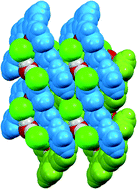Synthesis, X-ray characterization and DFT studies of bis-N-imidazolylpyrimidine salts: the prominent role of hydrogen bonding and anion–π interactions†
Abstract
Five new proton transfer compounds, (bimipyrH2)(Cl)2 (1), (bimipyrH2)[(NO3)(NO3HNO3)] (2), (bimipyrH2)(ZnCl4) (3), (bimipyrH2)(CdCl4) (4) and (bimipyrH2)(HgCl4) (5) (bimipyr = 4,6-di(1H-imidazol-1-yl)pyrimidine), have been synthesized and characterized by elemental analysis, IR and NMR spectroscopy and single crystal X-ray diffraction. Crystallographic analysis revealed that the asymmetric unit of 1 consists of one doubly protonated bimipyr molecule, one solvent water molecule and two chloride anions. Conversely, 2 is anhydrous where one counterion is chelated by the (bimipyrH2)2+ molecule and the other anion is solvated by the parent acid forming an independent ‘acid salt’ counterion [NO3HNO3]−. Both compounds exhibit diverse architectures involving hydrogen bonding and anion–π interactions. Compounds 3, 4 and 5 consist of outer sphere complexes of diprotonated bimipyr with [MCl4]2− as the counterion. They have the same molecular composition and compounds 4 and 5 (M = Cd and Hg, respectively) are essentially isomorphous and crystallized in the monoclinic space group P21/n. In the crystal structures of the five salts, N–H⋯Cl/O and C–H⋯Cl/O hydrogen bonds as well as anion–π, involving aromatic rings and inorganic anions, and π-stacking interactions are described and analysed by means of density functional theory (DFT) calculations since they play an important role in the construction of three-dimensional supramolecular frameworks. Finally, aggregation studies of compound 1 in solution (DMSO) are also described and discussed.



 Please wait while we load your content...
Please wait while we load your content...